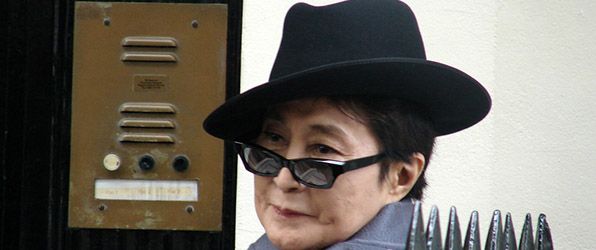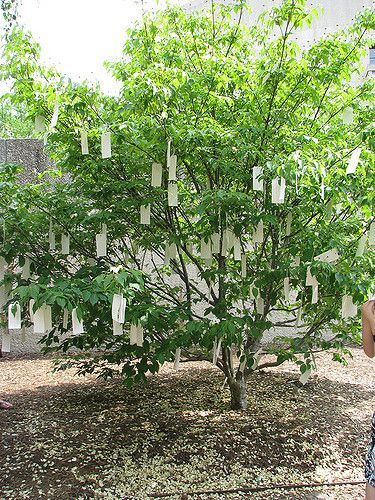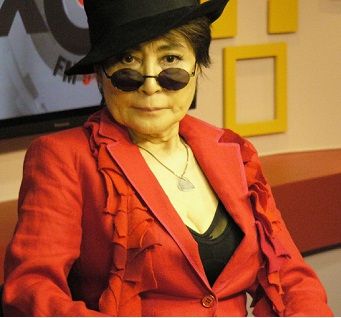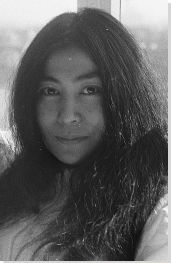That's why it's so easy to meet,
We're all water in this vast, vast ocean,
Someday we'll evaporate together."
Summary of Yoko Ono
Well before her famous partnership with John Lennon, Yoko Ono was the "High Priestess of the Happening" and a pioneer in performance art. Drawing from an array of sources from Zen Buddhism to Dada, her pieces were some of the movement's earliest and most daring. With unprecedented radicalism, she rejected the idea that an artwork must be a material object. Many of her works consist merely of instructions. In Cloud Piece (1963) for example, she instructs us to imagine digging a hole in the garden, and putting clouds into it. Ono faced the considerable challenge of remaining visible as an artist, not just a rock star's wife. For brief periods, the media's intrusive presence stopped her from working altogether. Remarkably, however, she persisted in sustaining a career that was well-established before Lennon's arrival on the scene, and which deserves to be admired in its own right.
Accomplishments
- Ono's fundamental contribution to the formation of Conceptual Art was involving the audience into the completion of the work. It is designed so that anyone can make it - a crucial dimension of its meaning.
- Ono was one of the strongest feminist voices to emerge from the art world in the 60s. Her Cut Piece (1964), a first for feminist art performance, invited audience members to take turns cutting off her clothes using a pair of scissors. It also brought the audience into close contact with the artist, which was a new concept and crossed traditional boundaries.
- A path-breaking force in eliminating boundaries among the arts, in the early 1960s, Ono opened her home to dancers, composers, and artists and encouraged them to work together. The building of interdisciplinary community is another great area of achievement in her career, and a fundamental aspect of her practice.
- A pioneer in music as well as art, Ono was trained as a classical pianist. She was also steeped in Japanese Imperial music (Gagaku). Her familiarity with both traditions captivated experimental Western musicians La Monte Young and John Cage (Cage's 4'33'' is essentially a translation of the famous Zen koan "What is the sound of one hand clapping?"). She in turn was influenced by them.
- Experiences, events, and performances form the backbone of her artistic practice. In this respect she is the quintessential conceptual artist. Her work is designed to redirect our attention to ideas, instead of appearances.
- Though her name has been unfairly associated with a woman who negatively affects a man's professional performance (Beatles fans often blame her for their breakup), Ono helped John become much more conceptual. She assisted him in moving away from the mainstream that the Beatles had previously inhabited, and encouraged him to develop an independent voice as a composer and musician.
The Life of Yoko Ono

Yoko Ono had a long career and was integral to many directions in art. She was always an active creator, known for saying "I thought art was a verb, rather than a noun."
Important Art by Yoko Ono
Painting to Hammer a Nail
Ono's most well-known works of the early 1960s are her "instructional pieces," so-called because the viewer is given instructions to follow. Following these instructions is an active part of making the work. This work consists of a canvas on a wood panel. Connected to the canvas is a hammer hanging from a chain. Nearby is a chair, with a jar of nails on it. Directions for the work ask the viewer to hammer a nail into the panel, and wrap a strand of his or her hair around it. Exhibited in 1966 in a gallery in London, the work was considered finished when the surface was completely covered in nails. Relinquishing her status as the author and empowering the public to complete the work was an incredibly radical concept for the time.
The idea that the work of art would be completed by the audience did, however, have antecedents in music. This is essentially an equivalent to John Cage's experimental "Four minutes, thirty-three seconds" (1952), in which the ambient noises in the room (furnished by the audience) throughout that brief period of time are considered the work. An early instance of Ono's brilliance as an innovator, this demonstrates her capacity to fuse musical concepts with new ideas that pushed the boundaries of visual art.
Canvas, Hammer, Chain, Nails - Seattle Art Museum
Bag Piece
More open-ended and audience focused than earlier "instructional pieces", Bag Piece instructed two individuals to enter a large black bag (an environment of complete darkness) and remove their clothes. After a few minutes, they were to put their clothes back on and exit. It was up to them to decide what to do while inside the bag. In this work, Ono's aim was to create a situation that diminished the power of race, gender, class, and other traditional distinctions. While for the two individuals inside the bag, these distinctions were diminished by blindness and vulnerability, observers on the outside were also unable to draw conclusions based on these traditional categories. The figures could be anyone. The work was inaugurated in Tokyo at the Sogetsu Art Center by Ono and Anthony Cox, her husband at the time.
Two audience members, and a black bag (Performance)
Cut Piece
A landmark work, and one of the artist's best-known, Cut Piece was presented at the Sogetsu Art Center, the same Tokyo venue that had hosted her Bag Piece. Ono wore one of her best suits and knelt on the stage holding a pair of scissors. She invited audience members to cut pieces of her clothing off using the scissors. The artist remained still and silent until she was down to only her underwear. The process of witnessing clothes cut from the body elicited a range of responses from the audience. Themes of materialism, gender, class, and cultural identity were central to the work.
According to Ono, her original intention was to harness the Buddhist mentality (Buddha, born a wealthy prince, achieved enlightenment by giving up everything and sitting under a tree for seven years), with a feminist subtext: women too often need to give up everything. This performance was a demonstration of that reality. Ono's Cut Piece was the first performance piece to address the potential for sexual violence in public spectacle. It is also among the first examples of Performance Art.
Body, Clothes, and Scissors (Performance piece)
Grapefruit
Both an artwork and a book, Grapefruit demonstrates the versatility of Ono's practice, and reminds us that, like many Conceptual artists, she found her way into visual art through writing. A series of instructions for living, Grapefruit contains over 150 written pieces divided into five sections: Music, Painting, Event, Poetry, and Object. Each piece is an instruction that can be completed in the reader's imagination or as an action. Cloud Piece reads as follows: "Imagine the clouds dripping. /Dig a hole in your garden to/ put them in." Ono had already performed some of the instructions for the public, such as "Leave a piece of canvas or finished painting on the floor or in the street." Grapefruit hands the whole process over to the audience.
First published in 1964 in Tokyo by Wunternaum Press, Grapefruit was tiny (5 2/5 in. by 5 2/5 in. by 1 3/10 inches), and referenced many of her artist friends such as La Monte Young. The book was republished by Simon & Schuster soon after with revisions and additions that made it more commercial, including a foreword written by John Lennon. Heavily informed by Zen Buddhism and Dada, the Western and Eastern traditions with which Ono was familiar, the book is regarded as a milestone of conceptual art.
Print book, Wunternaum Press
Play It By Trust aka White Chess Set
Ono's work of the mid 1960s veered toward minimalism. This piece, an all-white chessboard, exemplifies that trend in her work, while maintaining a connection with Ono's earlier instructional pieces inspired by Zen Buddhism and Dada (chess was Duchamp's favorite game). The work comes with the following instructions: "Play it for as long as you can remember/ who is your opponent and/ who is your own self." The question of how to move forward when one's opponent is indistinguishable from one's self is, of course, the central problem. Western audiences of the 1960s were beginning to take an interest in Eastern philosophies (Buddhism in particular) that believe that conflict resolution hinges on the understanding that everything is connected, and that we are all one. This piece was first presented at the Indica Gallery in London, and it demonstrated Ono's strong anti-war sentiments. She wanted players to see beyond black and white, explaining that "The problem is not how to become different or unique, but how to share an experience, how to be the same almost, how to communicate."
Painted Bronze - The Museum of Modern Art, New York
Ceiling Painting/ YES Painting
Like Ono's other pieces it is instructional. A white stepladder at the center of the room leads up to a framed glass panel. A magnifying glass hangs from a chain beside it. When one uses the magnifying glass to look at the framed glass panel, one sees the word "YES", written on a tiny piece of paper.
Ono describes the work as representing pain and the journey towards hope and affirmation, which can be difficult to attain and exists up high like some sort of cathedral. This piece also reflects her personal philosophy. The positivity in this particular work was what brought her together with her future husband, John Lennon, who was so delighted by this upbeat piece that he asked to be introduced to the artist, who (rather remarkably) didn't know who he was.
Text on paper, glass, metal frame, metal chain, magnifying glass, painted ladder (Performance)

Wish Tree
Since the 1990s, Yoko Ono's Wish Tree has appeared in an array of contexts and countries around the world. Ono asks audience members to write down wishes on cards, and hang them on a tree. The museum staff then gathers the wishes and returns them to Ono, who buries them at the base of her Imagine Peace Tower in Rijkavik, Iceland. Wish Tree is evidence that despite the interdisciplinary and experimental nature of her work, Ono's approach as a conceptual artist has remained remarkably consistent. Like other major works by Ono, Wish Tree relies on audience participation. Ono provides the idea, circumstance, and materials, and then steps aside to let the work take shape. The premise is egalitarian and the execution simple, but the symbolism is complex, elegant, and even devotional. According to the artist, a childhood memory of writing wishes on small pieces of paper she hung from flowering branches in a temple garden served as the inspiration for this work. The ceremonial display and subsequent burial of wishes from all over the world disseminates Ono's universal message of peace.
Mixed Media (tree, paper tags, string) - Traveling exhibition
Voice Piece for Soprano
Typical of Ono's anti-authoritarian stance toward institutions, this interactive work, composed in 1961, instructs participants to break a cardinal rule of museum etiquette. Ono, a trained vocalist, composed Voice Piece for Soprano in 1961. It consists of an empty room with text on one side that reads "Scream against the wind/against the wall/against the sky." At the other end is a microphone and loudspeakers. In 2010, it was installed in the massive atrium of the Museum of Modern Art (where noise travels everywhere, even without a microphone) and instantly became one of the most popular and controversial works on view at the museum. Against the artist's wishes, the museum ultimately turned the volume down, in response to complaints from staff that the blood-curdling screams were intolerable. Inspired partly by the work of John Cage, one of Ono's mentors, this brilliantly transgressive work liberates us from one of our most fundamental inhibitions, by inviting passionate chaos into the art world.
Performed in the Atrium of MoMA, July 2010
Biography of Yoko Ono
Early Years
Yoko Ono was the eldest of three children, born to Isoko and Eisuke Ono, conservative Japanese aristocrats. Yoko's mother was a painter. Her father wanted to be a concert pianist, but had given up his dream career to be a banker, and sought to live vicariously through his talented daughter Yoko, sending her to music school at the age of four. She later moved on to one of Japan's most exclusive schools, Gakushuin. Ono had a strained relationship with her mother, who resented her own children, feeling that they were a drain on her enjoyment of upper class life in Tokyo. She later told Ono never to marry and never to have children. Ono's childhood was isolated. Despite being wealthy, she was neglected by her parents, who were too busy to show affection. As a child, she rang for the maid simply in order to see someone. Her creativity and musicality provided the comfort she very much needed.
In 1945 American planes bombed Tokyo, forcing Ono and her family to flee into the countryside. They had to forage for food traveling from farm to farm with their few belongings. Ono and her family were reduced to skin and bone; farmers who resented the population fleeing from cities threw stones at them. Ono remembers being drawn to the beauty of the sky during those times. The next year her school reopened and she continued her studies, graduating in 1951. She was the first woman to be accepted into the philosophy program at Gakushuin University. After two semesters, however, she left to join her family, who had moved to Scarsdale, New York. She attended Sarah Lawrence College and was drawn to the radical politics of the small liberal arts college, where she met artists and poets. She had planned to be a writer, but her writings didn't fit the Western academic mold embraced by her professors at Sarah Lawrence, although she continued utilizing her musical talents.
She discovered the work of New York avant-garde composer John Cage and befriended him and others such as La Monte Young. Here Ono found her niche. Cage, Young, and other early members of this avant-garde movement were heavily inspired by the elite cultural traditions of Japan, and Ono's background was a distinct advantage as opposed to a drawback, as it had been in literary circles. Ono began dating Toschi Ichiyanagi, a Juilliard student who shared her passion for avant-garde intercultural music, and wrote her first composition, Secret Piece, in 1955. Against her parents' wishes Ono left college and married Ichiyanagi. The two moved to Manhattan, where she began to pursue her life as an artist.
Mature Period
During the sixties, Ono gravitated toward the circles of artists participating in "happenings," and held events at her own loft at 112 Chambers Street in New York City. Fluxus artists, avant-garde musicians, and other performers gathered there on a regular basis. Ono became the informal curator of the downtown arts scene in this space, and was known as a one-woman powerhouse. Named the "High Priestess of the Happening" Ono was considered a lightning rod for culture, always at the cutting edge of emerging trends in visual art and performance. La Monte Young, John Cage, Marcel Duchamp, Peggy Guggenheim, Jasper Johns and Robert Rauschenberg were among the artists she hosted in her loft at 112 Chambers Street. Evening events typically drew as many as 200 people.
During this time Ono supported herself as a secretary and a teacher of traditional Japanese arts. In 1961 she had her first solo show. She divorced her first husband and wed American jazz musician, film producer, and art promoter Tony Cox, and a year later the two had a daughter named Kyoko. Ono had established herself in the underground art scene by the mid-sixties. She performed musical pieces and was a reluctant part of the Fluxus art group, she was a seminal figure at its inception but didn't want to remain associated with it as she valued her independence as an artist. She published her legendary book of performance poetry called Grapefruit (1964) and began making films. After performing her now-famous Cut Piece, she was invited to hold an exhibition at the Indica Gallery in London. As she was preparing the exhibit, John Lennon came in to view the exhibit. He admired her artworks and was especially taken with YES (1966), a small affirmative painting at the top of a ladder, which he appreciated for its positivity. He also enjoyed Hammer A Nail (1966) and although the exhibition hadn't yet opened asked if he could hammer in a nail, when Ono said no the gallery owner took her aside and explained that Lennon was a millionaire and might buy the piece. Ono hadn't heard of the Beatles. She agreed that John could hammer in a nail for five shillings. Lennon replied that in exchange for an imaginary five shillings he'd hammer in an imaginary nail.
Drawn together by their love of words and music, they began to collaborate on performance and film. By 1969 Ono had divorced Cox and married Lennon. Cox won custody of Kyoko and bitterly resisted Ono's visitation rights. In 1971 he fled with Kyoko to Los Angeles and joined a cult. Despite an official investigation, Ono and Lennon were unable to trace the whereabouts of him or the child. They finally resurfaced in 1986. By then Kyoko was 22, and she and Ono have since remained somewhat estranged. An open letter from Ono to her daughter, the year that she was found, gives us some insight into this tumultuous period in her life, as well as the strength of her character: "Dear Kyoko, All these years there has not been one day I have not missed you. You are always in my heart. However, I will not make any attempt to find you now as I wish to respect your privacy. I wish you all the best in the world. If you ever wish to get in touch with me, know that I love you deeply and would be very happy to hear from you. But you should not feel guilty if you choose not to reach me. You have my respect, love and support forever. Love, Mommy"
This ongoing personal drama and her relationship with one of the most famous people in the world put a strain on Ono's career in the 1970s and 80s. Her avant-garde friends thought she was getting too mainstream. Ono's personal practice waned as her work ethic needed focus and with John at her side her attention became split. The high-profile relationship was hard for Ono as she and John were not liked very much by the public, and many thought Ono was taking Lennon away from his famous band. Girls were also jealous of her. Ono felt she needed space from it and she and Lennon took some time apart physically, but remained close talking every day. A year later she and Lennon got back together and she became pregnant. At the age of 42, Ono was afraid of miscarrying again, since she had lost several pregnancies already. Therefore, she spent most of that time in bed. John would push her around the house in a wheelchair so they could share meals. In 1975 their son Sean was born. Lennon took care of the baby while Ono ran the business side of their shared record label, Lenono (a contraction of their two names). In 1980, an unthinkable tragedy occurred: her husband was shot and killed outside of their home in New York.
Late Period
A rush of media attention followed Lennon's death, but Ono went into seclusion. Over the course of the 1980s she gradually reemerged as an artist and public figure, returning to musical, written, and visual pieces from previous years. Ono never remarried, but kept her late husband's legacy alive, creating the LennonOno Grant for Peace in 2002 and inaugurating a structure in 2007 called the Imagine Peace Tower in Iceland. She has continued to pursue her career as an experimental composer and has released three solo albums, touring, and composing two off-broadway musicals. Now in her eighties, Ono continues to work for peace, and sees things with ardent optimism, claiming we will see peace on earth in the year 2050. She spreads the message through her work and life that the future is now. Her album, titled "Yes, I'm a Witch" (an arch nod to her public image), released in 2007 in collaboration with music giants such as DJ Spooky, Cat Power, and the Flaming Lips, topped the charts with numerous dance hits and collaborations, and reflects Ono's indomitable spirit.
The Legacy of Yoko Ono

Ono's performances and instructional paintings of the early 1960s changed forever the relationship between artist and audience. Bed-In and Bagism, pieces staged in 1969 with Lennon, are direct antecedents for subsequent works that turned private life into public spectacle, most famously Tracy Emin's My Bed (1998) and her involvement in the peace movement encouraged future generations of artists to use visual art as a political platform. Her mutually influential partnership with John Lennon is well-traversed territory, but it is worth remembering that in leading us through the process of imagining a different, better world, Lennon's famous solo song "Imagine" is essentially a reprise of Yoko's instructional pieces. Ono's innovative, iconoclastic presence in the art world extended far beyond this partnership, furthering the dialogue on materialism and cultural consumerism in a way that has inspired Rirkrit Tiravanija, Suzanne Lacy, and other artists involved in social practice. Finally, in calling attention to the vulnerability and resilience of the female body, Ono gave future female performance artists, among them Valie Export, Hannah Wilke and Marina Abramovic, permission to take even greater risks.
Influences and Connections

-
![John Cage]() John Cage
John Cage ![Jackson Mac Low]() Jackson Mac Low
Jackson Mac Low
Useful Resources on Yoko Ono
- Yoko Ono: Collector of SkiesOur PickBy Nell Beram
- Reaching Out with No Hands: Reconsidering Yoko OnoBy Lisa Carver
- Yoko Ono: Between the Sky and My HeadBy Thomas Kellein




























